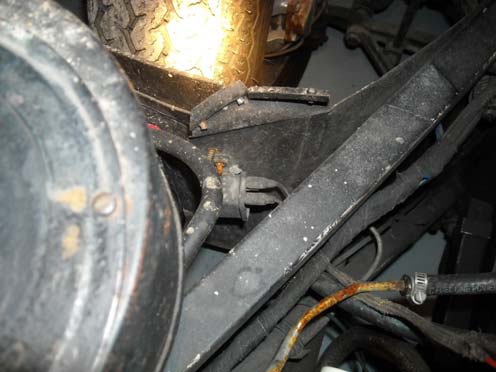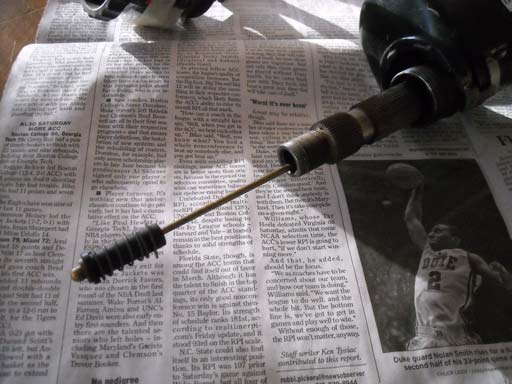Tech Session - Restoration of an E-type:
Troubleshooting the E-Type Horn (50th in a series)
By Harvey Ferris
I have recently run into 2 problems with the horn on my E-Type. One problem is that is won't "toot." The other problem is I can't make it stop! The latter gets your attention rather quickly!
The actual horns (there are 2 of them to give a high/ low tone) are mounted under the front "picture frame." They are fed electrically by a relay that is mounted on the back side of the splash panel for the left front tire (see photo). This relay is a switch that is activated by the horn button but sends the relatively high current required by the horns more directly to them, without passing it through the steering column. Both the relay and the horn button are fused. I see that fuse 3 is used for the relay and fuse 6 for the horn button. Pushing the horn button grounds one side of the relay, causing it to switch on and sound the horns.
If you find that your horns are blaring and you can't make them stop, there are 2 immediate actions you can take. You can drop the center console and start pulling fuses until it stops. You can figure which fuse actually did the trick later, at this point you just want the noise to quit. Alternatively, you can pop the hood and start disconnecting wires from the relay on the back side of the splash panel. One of these actions will surely silence your horns.
If your horns quit working, you are also faced with a troubleshooting effort - you will just have less of a sense of urgency. Troubleshooting is a matter of tracing the key circuits to isolate the problem. If you are electrically inclined this is a pretty simple circuit that you should be able to figure out. If you aren't electrically inclined, you could at least check the fuses and maybe replace the relay. They are inexpensive devices. Wiring very rarely fails randomly. It can be challenged at "choke points" like where it goes through openings in the body.
Connections at the end of a wire are always suspect. You can try removing all the connections to the horn relay and spray both male and female parts with an electrical contact cleaner, such as CRC Electronic Cleaner. The older style fuses used on Jaguars are subject to corrosion in-place. Sometimes just spinning the fuse will improve the connection. The electronic cleaner can help here, too.
One area of the horn system that I find to be somewhat delicate is the part mounted inside the steering column. The horn button is released by partially backing out the 3 set screws behind the wheel hub (see photo). Once the screws are loosened the button will pull right out. From there you will see the end of a small round brass rod, underneath which is a black plastic insulating sleeve and a spring. If the spring is missing, the rod won't make contact with the button and there is your problem (see photo). This assembly of parts can be pulled straight outward and laid aside, which is necessary if you want to loosen the big nut that holds on the steering wheel and remove it.
The problem I see is that the long brass rod extends down into the interior of the steering column, where there is an insulated contact that passes through the side of the steering column to a curved brass plate that is attached to an insulated mounting point. The mounting point contains a "bullet connector" to which is attached the wire that goes off to the relay. The wire should be purple/black. Don't confuse this with the ground wire, which also attaches to a curved brass plate. Ground wires are typically black. The ground wire connection is the first one you come to as you work down the steering column from the steering wheel end. See the picture I took of the steering column out of a 1963 car. I call both of these connections wipers because they "wipe" the rotating shaft that turns with the wheel. Obviously, these parts get a lot of action due to the constant turning of the wheel. They are prime candidates for trouble.
Electrically you need 2 things. With the brass rod inserted and the horn button in place, the bullet connector should not be grounded until you push the horn button. Put your test leads on the bullet and ground connectors and check for continuity. If there is continuity without the horn button being pressed, the horn will be activated all the time. Conversely, if there is no continuity when the horn button is pressed, there is the reason your horn is not working.
The ground wire is pretty simple. The wiper wipes directly on the rotating shaft of the steering column. The hot lead has a tougher job. It has to wipe on that long brass rod located in the center of the column. The way it does this can only be seen by pulling the steering column shaft out, as you might do when replacing the steering column "bearings" (a very generous term for 2 round circles of some sort of plastic material at each end of the column!). If you get into it this far, you will be able to see the key parts. If the parts shift a little or become worn, the isolative measures will be defeated, you will have a short, and the horn will blare. I had to fix mine with a small brass machine screw, modified suitably, and the spring from a ball point pen. Alignment is critical but it can be done.
So there are some ideas about troubleshooting your horn. Although I don't own any similar vintage XK or XJ cars, I strongly suspect the key elements of this discussion apply to them also. Armed with this knowledge, no one should show up at the Concours this summer and have to take a deduction because their horn doesn't work!
If you have any questions about E-Type restoration feel free to contact me at hdferris@bellsouth.net. Or see my website www.newhillgarage.com. Happy motoring!





